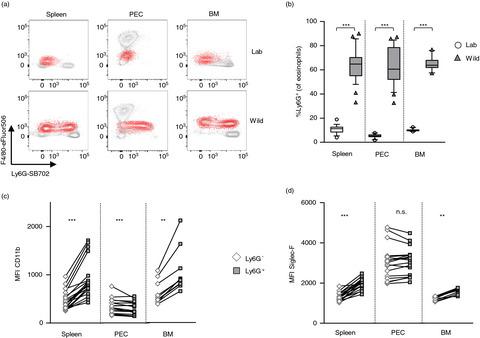当前位置:
X-MOL 学术
›
Immunology
›
论文详情
Our official English website, www.x-mol.net, welcomes your
feedback! (Note: you will need to create a separate account there.)
A lesson from the wild: The natural state of eosinophils is Ly6Ghi
Immunology ( IF 4.9 ) Pub Date : 2021-09-06 , DOI: 10.1111/imm.13413 Iris Mair 1 , Andrew Wolfenden 2 , Ann E Lowe 2 , Alex Bennett 1 , Andrew Muir 1 , Hannah Smith 1 , Jonathan Fenn 2 , Janette E Bradley 2 , Kathryn J Else 1
Immunology ( IF 4.9 ) Pub Date : 2021-09-06 , DOI: 10.1111/imm.13413 Iris Mair 1 , Andrew Wolfenden 2 , Ann E Lowe 2 , Alex Bennett 1 , Andrew Muir 1 , Hannah Smith 1 , Jonathan Fenn 2 , Janette E Bradley 2 , Kathryn J Else 1
Affiliation

|
With a long history of promoting pathological inflammation, eosinophils are now emerging as important regulatory cells. Yet, findings from controlled laboratory experiments so far lack translation to animals, including humans, in their natural environment. In order to appreciate the breadth of eosinophil phenotype under non-laboratory, uncontrolled conditions, we exploit a free-living population of the model organism Mus musculus domesticus. Eosinophils were present at significantly higher proportions in the spleen and bone marrow of wild mice compared with laboratory mice. Strikingly, the majority of eosinophils of wild mice exhibited a unique Ly6Ghi phenotype seldom described in laboratory literature. Ly6G expression correlated with activation status in spleen and bone marrow, but not peritoneal exudate cells, and is therefore likely not an activation marker per se. Intermediate Ly6G expression was transiently induced in a small proportion of eosinophils from C57BL/6 laboratory mice during acute infection with the whipworm Trichuris muris, but not during low-dose chronic infection, which better represents parasite exposure in the wild. We conclude that the natural state of the eosinophil is not adequately reflected in the standard laboratory mouse, which compromises our attempts to dissect their functional relevance. Our findings emphasize the importance of studying the immune system in its natural context – alongside more mechanistic laboratory experiments – in order to capture the entirety of immune phenotypes and functions.
中文翻译:

来自野外的教训:嗜酸性粒细胞的自然状态是 Ly6Ghi
具有促进病理性炎症的悠久历史,嗜酸性粒细胞现在正在成为重要的调节细胞。然而,迄今为止,受控实验室实验的结果还没有转化为自然环境中的动物,包括人类。为了在非实验室、不受控制的条件下了解嗜酸性粒细胞表型的广度,我们利用模式生物Mus musculusdomesticus的自由生活种群。与实验室小鼠相比,野生小鼠脾脏和骨髓中的嗜酸性粒细胞比例显着更高。引人注目的是,野生小鼠的大多数嗜酸性粒细胞表现出独特的 Ly6G hi实验室文献中很少描述表型。Ly6G 表达与脾脏和骨髓中的激活状态相关,但与腹膜渗出细胞无关,因此本身可能不是激活标记。在急性感染鞭虫Trichuris muris期间,在来自 C57BL/6 实验室小鼠的一小部分嗜酸性粒细胞中瞬时诱导了中间 Ly6G 表达,但不是在低剂量慢性感染期间,这更好地代表了野外寄生虫暴露。我们得出结论,嗜酸性粒细胞的自然状态在标准实验室小鼠中没有得到充分反映,这损害了我们剖析其功能相关性的尝试。我们的研究结果强调了在自然环境中研究免疫系统的重要性 - 以及更多机械实验室实验 - 以捕捉整个免疫表型和功能。
更新日期:2021-11-04
中文翻译:

来自野外的教训:嗜酸性粒细胞的自然状态是 Ly6Ghi
具有促进病理性炎症的悠久历史,嗜酸性粒细胞现在正在成为重要的调节细胞。然而,迄今为止,受控实验室实验的结果还没有转化为自然环境中的动物,包括人类。为了在非实验室、不受控制的条件下了解嗜酸性粒细胞表型的广度,我们利用模式生物Mus musculusdomesticus的自由生活种群。与实验室小鼠相比,野生小鼠脾脏和骨髓中的嗜酸性粒细胞比例显着更高。引人注目的是,野生小鼠的大多数嗜酸性粒细胞表现出独特的 Ly6G hi实验室文献中很少描述表型。Ly6G 表达与脾脏和骨髓中的激活状态相关,但与腹膜渗出细胞无关,因此本身可能不是激活标记。在急性感染鞭虫Trichuris muris期间,在来自 C57BL/6 实验室小鼠的一小部分嗜酸性粒细胞中瞬时诱导了中间 Ly6G 表达,但不是在低剂量慢性感染期间,这更好地代表了野外寄生虫暴露。我们得出结论,嗜酸性粒细胞的自然状态在标准实验室小鼠中没有得到充分反映,这损害了我们剖析其功能相关性的尝试。我们的研究结果强调了在自然环境中研究免疫系统的重要性 - 以及更多机械实验室实验 - 以捕捉整个免疫表型和功能。











































 京公网安备 11010802027423号
京公网安备 11010802027423号